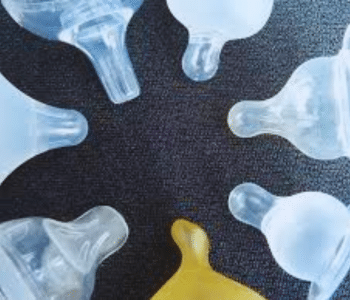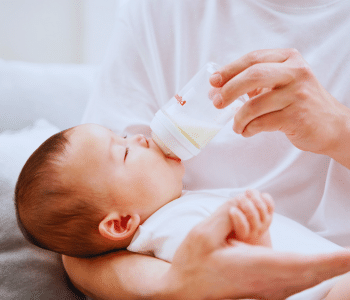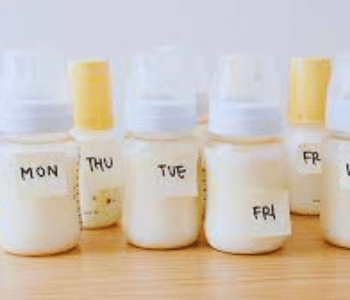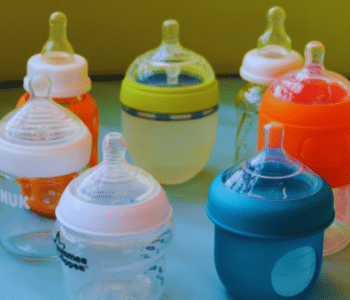When I was twenty-two years old, I wanted two things: 1. To be understood. 2. For people to think I was good at my job....Read more
What will you need when you have a baby, among other things? Infant bottles. You intend to breastfeed your child . There may come a time when you want to take a short break and ask your partner to assist with feeding.
When creating your baby registry, baby bottles are a rule. But how can you be certain that you’re picking the proper bottles when there are so many options available. Babies have various preferences? You should think about a number of factors.

So, have a plan and know what to search for before making your sale . And before scouring the internet or the baby bottle section of your local retailer. Before your baby is born, use this list to help you choose at least one or two high-quality baby bottles. Once your baby is here, he can decide which one he prefers.
How Do I Know What Bottles To Use For My Baby?
There are two types of bottles: the smaller ones hold 150 ml (5 fl oz), and the larger ones hold 250 ml (9 fl oz). Due to their small stomachs, babies feed frequently and seldom throughout the first few weeks. The smaller bottles work better during this time.
Larger bottles allow babies to drink more milk, which may result in overfeeding. As a baby develops and their milk intake rises, bottle-feeding parents may need to switch to using larger bottles.
As each baby is unique, there is no standard age at which this should occur. It’s crucial to pay attention to your baby’s feeding cues and indications. They require milk, such as finishing each feeding and appearing to want more.
Go with your instinct when it comes to attempting various flow nipples and moving on to the next level of flow because you know your kid best.
It’s normally advised to continue with a steady flow while bottle-feeding a baby who has been breastfed. That typically replicates the flow at the breast. It reduces the likelihood that your infant will start to favor the faster flow of the bottle nipple.
Benefits And Drawback
The following characteristics are necessary for bottle-feeding:
1. Versatility
Bottles generally have the advantage that either parent can feed the infant. Feeding is a significant time for bonding, and although bottle feeding allows both parents to spend time with the infant. They develop a close relationship, breastfeeding prevents the other parent from doing so.
2. Monitor your infant’s milk consumption
When feeding your baby from a bottle, you always know exactly how much they consume, ensuring that they get enough nourishment. If you are concerned about your baby obtaining enough food, it may help you feel more at ease.
3. Simple to combine bottle and breastfeeding
If you frequently express breast milk, our baby bottles are also wonderful for storing it and using it for “on-the-go” feeding.
The most crucial factor is making the decision that is best for you and your child so that you can have a contented and full-grown child. In any case, feeding your infant should be a comfortable experience for both you and the baby. It’s also a wonderful opportunity for bonding.
A newborn needs twice as long to absorb infant formula as they do breast milk. Infant formula’s slower absorption when given as a bottle can have the following effects:
Feeding routine. Infants who consume infant formula typically prefer to eat less frequently than infants who are breastfed.
Bowel motions. Brown-formed stools with a strong stench are a result of infant formula. Stools produced by breast milk are loose, yellow, and less odoriferous.
Contrary to formula, breast milk contains antibodies. Your child may experience fewer infections if you breastfeed. Additionally, breast milk may help shield your child from some illnesses, including diabetes. See the breastfeeding article for further details.
How do I know if my baby has the right bottle?
Many baby bottles are composed of plastic, as you will discover. Choosing plastic bottles is a wise move. They are affordable and practical for parents because they are light and durable.

Glass is inherently free of hazardous chemicals composed of natural materials. And dishwasher safe. Thus, glass bottles give parents peace of mind. They are less likely to get scratched than plastic bottles and can handle hot water when boiling to sanitize.
A good compromise between glass and plastic bottles is silicone bottles. Although they are not as sterile, weighty, or breakable as glass, they are also not as porous and stain-prone as plastic.
Disposable plastic liners are used in some baby bottles. Parents appreciate that they warm up more quickly, clean up takes less time, and collapse to create air-free feedings that use less air. Even while these liners are really useful, they end up costing more and are not environmentally friendly because they can only be used once.
Which brand of baby bottle is best?
Consider Como tomo baby bottles if you’re searching for the best bottle for newborns or simply a silicone choice that won’t let you down.
Boon NURSH Reusable Silicone Baby Bottles are the best option for a silicone bottle.
Another excellent silicone alternative is Boon. It has a special and revolutionary silicone pouch. It begins to collapse and contract when your baby moves. This makes this brand perfect for nursing parents. because it not only reduces gas but also simulates how your breast starts to deflate during a feeding.
The Ola Baby Gentle Bottle 2 Piece Frost Set is the easiest baby bottle to clean.
Silicone is flexible and can wrap around a bottle brush more readily than other materials. You can almost always count on a silicone baby bottle is easier to clean than a baby bottle made of another material.
What size bottle is best for babies?
There are two types of bottles: the smaller ones hold 150 ml (5 fl oz), and the larger ones hold 250 ml (9 fl oz). Due to their small stomachs, babies feed frequently and seldom throughout the first few weeks. The smaller bottles work better during this time.
Compared to 6-month-olds, newborns require more frequent feedings but consume less liquid. It’s helpful to read the AAP recommendations for infant feeding amounts. Many parents start their infant on a 2-, 4-, or 5-ounce bottle and gradually increase the size as their child develops to an 8-, 9-, 10-, or 11-ounce bottle.
Typically, bottles come in two sizes: small (about 4 ounces) and large (about 8 ounces). Small sizes are practical when a baby is a newborn because they only consume about 2-3 ounces every feeding. Babies outgrow small bottles rapidly, so if you like to save money, you can start using large bottles right away instead.
Children require bottles that will keep them hydrated throughout the course of a day at camp. Daycare, or school without the need for frequent refills yet that aren’t too large to be cumbersome to carry. We advise using a bottle that weighs no more than one pound and can hold 12 to 22 ounces of liquid.
What type of baby bottles are safe?
Glass infant bottles are secure and free of dangerous substances like BPA and BPS. They can tolerate both hot and cold liquids without losing their shape or texture. Glass, stainless steel, or silicone baby bottles are the safest options. These substances do not contaminate your baby’s formula or breast milk with hazardous compounds.
Glass is likely the safest material for baby bottles. Milk or infant formula won’t be contaminated by glass bottles. When feasible, use glass to store breast milk as well.
Baby-safe BPA-free polypropylene is available. Sturdy polypropylene, which is devoid of potentially dangerous BPA, is used to make natural Philips Avent bottles. Using any Philips Avent steam sterilizer or boiling water, polypropylene is extremely simple to clean.
How long can we use the same feeding bottle?
Replace plastic water bottles every four to six months. After around six months, BPA-free bottles should be thrown away. It is advised to abide by any directions on the packaging regarding the appropriate disposal period. It is typically four months.

Every 4-6 months, the bottle should be changed, according to recommendations. If glass bottles are in good shape, they might not need to be replaced as regularly. Your bottle’s longevity and safety can be increased with the right upkeep and care.
Each time a child is fed, the bottle should be cleaned. Throw away any unfinished formula if your infant doesn’t finish a bottle within two hours. If the formula or breast milk is added to a partially used bottle, or if a used bottle is just washed rather than cleansed, germs can quickly proliferate.
Is Mam or Tommee Tippee better?
It takes some trial and error to choose the ideal bottle for your baby’s feeding requirements! Brands of baby bottles come with a variety of features, such as extra slow-flow nipples and anti-colic vents. You’ve come to the right place if you’re comparing bottles from Tommee Tippee and MAM. Continue reading to learn more about the variations and parallels between these two brands.
Anti-colic systems are present in bottles from Tommee Tippee and MAM. Their nipples are made to make transferring from breast to bottle and latching on simple. MAM sells glass and plastic bottles. There are only plastic bottles of Tommee Tippee. MAM distinguishes out for its self-sterilizing function, which has won honors.
MAM’s Easy Start Anti-Colic Baby Bottle includes a special self-sterilizing technology. It makes cleaning as simple as 1-2-3! Before sterilizing the bottle in the microwave for three minutes. assemble it according to the manufacturer’s instructions. Dishwasher safety applies to all MAM bottles and components.
Bottles from Tommee Tippee are simple to clean. They can be put in the dishwasher or washed in warm, soapy water. Put the components in a dishwasher basket meant for baby bottles, set it on the top rack, and you’re ready to go!
MAM bottles are created.How? Through premium pharmaceutical-grade glass or BPA- and BPS-free polypropylene plastic. Silicone is used to make the nipples. All Tommee Tippee bottles are composed of soft-feel silicone or plastic that is 100% BPA-free. anti-static, odor- and stain-resistant.
MAM bottles, are they anti-colic?
The best colic defense is offered to parents by MAM Easy Start, which also makes switching between breast and bottle feeding simple. The distinctive vented base promotes a smooth flow of liquid. infants consume unhurriedly and comfortably.
The new MAM Anti-Colic bottles include a self-sterilizing feature that makes them ready to use after only three minutes. in the microwave. it negates the need for a sterilizer. The holes in the bottle’s base, which are intended to reduce colic by up to 80%, lessen colic symptoms by limiting the amount of air that the infant swallows.
You may move between the breast and bottle with ease since MAM bottles have an extended nipple with a natural feel. Uniform better, the novel vented base promotes a uniform drinking flow to lessen gas, spit-up, and general fussiness in newborns.
What advantages and disadvantages do MAM bottles have?
Since MAM’s bottle has a venting system in the bottom, air exits the rear as the infant drinks.
The nipple of MAM is unique compared to most others because it has the business’s “patented silk surface.”
This bottle delivered decent performance and quality for the money. It might be a terrific alternative to add to your list while you’re testing to find the bottle that makes your child the happiest. All the qualities it offers, including a couple that isn’t present in any other bottle.
It can be challenging for small hands to hold onto when feeding. it is not as elegant as other bottles from the manufacturer and is fairly hefty with a really big base. Some parents will appreciate the modern and appealing shape that is a little odd.
The bottle’s design isn’t for everyone, and its thick base makes it difficult to grip with small hands.
Final thoughts

While there are some items you should stock up on before your kid is born, bottles are not one of them. Some bottles are touted as magical feeding unicorns. your baby’s approval will ultimately determine which ones you choose. So, begin with a small number (perhaps even two distinct categories). In this way, you won’t be left with a stockpile of bottles that your child might reject.

When I was twenty-two years old, I wanted two things: 1. To be understood. 2. For people to think I was good at my job. As a first time founder, I remember feeling under-qualified. I felt like an impostor—and it showed. I struggled to communicate my value in a way that my colleagues and potential investors could understand. I realized I needed to clarify my message and use social media as a tool to help me build my personal brand. This would help me look more credible, I thought. So I got to work. I updated my social media profiles, built a personal website, and began sharing my story online. The more content I shared, the more confident I became. And the more confident I became, the more credible I appeared. Now i am writing blogs for madeforkids.co.uk on different topics on kids.
- Latest Posts by Anna Vatuone
-
What Are The Uses Of A Drone
- -
What Are The Uses Of Playhouse
- -
How To Get A Child To Warm Up To You
- All Posts
